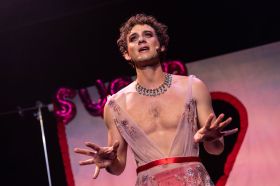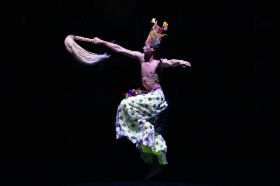The audience leapt to its feet on opening night to applaud the virtuoso performance of Zahra Newman and the technical brilliance of director Kip Williams and his team’s third instalment of his Gothic trilogy, Dracula, based on the work by Bram Stoker.
Newman is quite simply astonishing, her exceptional range, timing and vocal prowess all utilised to great success in this breathtaking tour de force performance. She delivers a powerful and mischievous interpretation that manages to be unique, while still paying homage to previous incarnations of the tale.
Once again live video dominates the evening and a single giant screen turns the stage even more into a cinema than either of the preceding two instalments of the trilogy. This style of performance now has a name it appears. Sydney Theatre Company CEO Anne Dunn dubs it ‘cine-theatre’ in the program notes. And it’s an accurate name because the detail of the story really does appear primarily on screen, and that we are in a theatre space is often quite irrelevant to the storytelling.
Those familiar with his first two adaptations of the The Picture of Dorian Gray and Strange Case of Dr Jekyll and Mr Hyde stories will appreciate the further heightened technical achievements of this Dracula, where additional characters have been pre-filmed and inserted on the screen where not present on the stage, allowing Newman to inhabit a variety of personas at the same time and interact with herself.
While technically brilliant, there are moments where the costume and make-up do become rather comical – although that may perhaps have been the intent. For there are more laughs than expected during the evening as B movie references and copious gore occasionally tip the action into Halloween cosplay territory.
Once again, the often rather techno style music at times leads the storytelling to a more comic than atmospheric ambience and the reason for this is unclear. But the audio and visual teams’ expertise is undeniable and, if you are a fan of cinema, it is for the most part quite rewarding. Being able to see the nuance of Newman’s performance in tight close-up is reason enough to welcome the camera’s viewpoint.
But it is a longish show without an interval and the work does seem to lose its clarity and become rather confusing once it passes the graveyard scene. In an effort to reinforce the premise anchoring this adaptation – that monsters are really manifestations of our own minds – many of the visual cues established early in the work to define character are abandoned in a flurry of discarded wigs as individual storytellers become blurred or overlayed, and more universal experiences are explored.
The sudden introduction of an impressive theatrical effect snowstorm does wrench us back to the world of the stage momentarily, but by this time we are closely engaged with the action on screen and the storytelling surprisingly loses some focus as a result.
The evening is nevertheless an impressive experience and you don’t have to know the first two works to appreciate this third instalment as a stand-alone performance. But there are also a few new tricks to enjoy if you are a returning punter.
Read: Sonic and graphic review: Pink Floyd Dark Side of the Moon, Scienceworks Planetarium
If you are a fan of the immediacy of live theatre and the magic that the interaction of multiple performers can create, you should probably leave that expectation at the door. Remember this is a genre all its own – ‘cine-theatre’. It’s still with impressive performance and storytelling, but certainly more dominated by the ‘cine’ than the ‘theatre’.
Dracula by Bram Stoker
Adapted and Directed by Kip Williams
Roslyn Packer Theatre, Sydney Theatre Company
Designer: Marg Horwell
Lighting Designer: Nick Schlieper
Composer: Clemence Williams
Sound Designer: Jessica Dunn
Video Designer: Craig Wilkinson
Assistant Video Director: Bejamin Sheen
Video Editor: Susie Henderson
Associate Director: Ian Michael
Assistant Director: Nicole Pingon
Sound System Designer: Hayley Forward
Cast: Zahra Newman
Tickets: $75-$155
Dracula will be performed until 4 August 2024.






